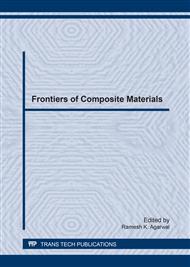[1]
Jandas PJ, Mohanty S and Nayak SK. Renewable reseource-based biocomposites of various surface treated banana fibre and poly lactic acid: Characterization and biodegradability. Journal of polymer and environment. 2012; 20: 583-595.
DOI: 10.1007/s10924-012-0415-8
Google Scholar
[2]
Goriparthi BK, Suman KNS and Rao NM. Effects of fiber surface treatments on mechanical and abrasive wear performance of polylactide/jute composites. Composites: Part A. 2012; 43: 1800-1808.
DOI: 10.1016/j.compositesa.2012.05.007
Google Scholar
[3]
Zhao YQ, Cheung HY, Lau KT, et al. Silkworm silk/poly(lactic acid) biocomposites: Dynamic mechanical, thermal and biodegradable properties. Polymer degradation and stability. 2010; 95: 1978-(1987).
DOI: 10.1016/j.polymdegradstab.2010.07.015
Google Scholar
[4]
Yu T, Ren J, Li S, et al. Effect of fibre surface-treatments on the properties of poly(lactic acid)/ramie composites. Composites: Part A. 2010; 41: 499-505.
DOI: 10.1016/j.compositesa.2009.12.006
Google Scholar
[5]
Shukor F, Hassan A, Islam MS, et al. Effect of ammonium polyphosphate on flame retardancy, thermal stability and mechanical properties of alkali treated kenaf fibre filled PLA biocomposites. Materials and design. 2014; 5 (4): 425-429.
DOI: 10.1016/j.matdes.2013.07.095
Google Scholar
[6]
Suprakas SR and Mosto B. Biodegradable polymers and their layered silicate nanocomposites: In greening the 21st century materials world. Progress in material science. 2005; 50: 962-1079.
DOI: 10.1016/j.pmatsci.2005.05.002
Google Scholar
[7]
Pettersson l, Kvien K and Oksman K. Structure and thermal properties of poly(lactic acid)/cellulose whiskers nanocomposites materials. Composites science and technology. 2007; 67: 2535-2544.
DOI: 10.1016/j.compscitech.2006.12.012
Google Scholar
[8]
Huda MS, Mohanty AK, Drzal LT, et al. Green, composites from recycled cellulose and poly(lactic acid): Physico-mechanical and morphological properties evaluation. Journal of materials science. 2005; 40: 4421-4429.
DOI: 10.1007/s10853-005-1998-4
Google Scholar
[9]
Islam MS, Pickering KL and Foreman NJ. Influenced of alkali treatment on the interfacial and physic-mechanical properties of industrial hemp fibre reinforced polylactic acid composites. Composites: Part A. 2010; 41: 596-603.
DOI: 10.1016/j.compositesa.2010.01.006
Google Scholar
[10]
Masud S, Huda A, Drzal LT, et al. Effect of fibre surface treatments on the properties of laminated biocomposites from poly(lactide acid) (PLA) and kenaf fibres. Composites science and technology. 2008; 68: 424-432.
DOI: 10.1016/j.compscitech.2007.06.022
Google Scholar
[11]
Mohanty AK, Mishra M and Drizal LT. Surface modification of natural fibre and performance of the resulting biocomposites: An overview. Composites Interf. 2001; 8-5: 313-343.
Google Scholar
[12]
Alemdar A and Sain M. Isolation and characterization of nanofibers from agricultural residues – Wheat straw and soy hulls. Bioresource technology. 2008; 99: 1664 – 1671.
DOI: 10.1016/j.biortech.2007.04.029
Google Scholar
[13]
Li X, Tabil LG and Panigrahi S. Chemical treatment of natural fibre for use in natural fibre-reinforced composites: A review. Polymer Environment. 2007; 15(1): 25-33.
DOI: 10.1007/s10924-006-0042-3
Google Scholar
[14]
Mwaikambo L and Ansell M. Chemical modification of hemp, sisal, jute and kapok fibre by alkalization. Journal of applied polymer science. 2002; 84: 2222-2234.
DOI: 10.1002/app.10460
Google Scholar
[15]
Yousif BF, Shalwan A, Chin CW, et al. Flexural properties of treated and untreated kenaf/epoxy composites. Materials and design. 2012; 40: 378-385.
DOI: 10.1016/j.matdes.2012.04.017
Google Scholar
[16]
Chang VS and Holtzapple MT. Fundamental factors affecting biomass enzymatic reactivity. Applied Biochemistry and Biotechnology. 2000; 84–86: 5–37.
DOI: 10.1385/abab:84-86:1-9:5
Google Scholar
[17]
Teixeira LC, Linden JC and Schroeder HA. Simultaneous saccharification and cofermentation of peracetic acid-pretreated biomass. Applied Biochemistry and Biotechnology. 2000; 84–86: 111–127.
DOI: 10.1385/abab:84-86:1-9:111
Google Scholar
[18]
Yang B, Dai Z, Ding SY, et al. Enzymatic hydrolysis of cellulosic biomass. Biofuels. 2011; 2: 421–450.
Google Scholar
[19]
Rajeev K. Kenaf-reinforced polypropylene composites. Department of Chemical Engineering. Michigan State University. (1996).
Google Scholar
[20]
Masud SH, Lawrence TD, Amar KM, et al. Chopped glass and recycled newspaper as reinforcement fibers in injection molded poly(lactic acid) (PLA) composites: A comparative study. Composites science and technology. 2005; 66: 1813-1824.
DOI: 10.1016/j.compscitech.2005.10.015
Google Scholar
[21]
Bledzki, AK, Mamun, AA, Lucka-Gabor, M, Gutowski, VS. The effects of acetylation on properties of flax fibre and its polypropylene composites. eXPRESS polymer letters. 2008: 6: 413-422.
DOI: 10.3144/expresspolymlett.2008.50
Google Scholar
[22]
Mohd Edeerozey, AM, Akil, HM, Azhar, AB, Zainal Ariffin, MI. Chemical modification of kenaf fibers. Materials letters. 2007: 61: 2023-(2025).
DOI: 10.1016/j.matlet.2006.08.006
Google Scholar
[23]
Adel, AM, Abd El-Wahab, ZH, Ibrahim, AA, Al-Shemy, MT. Bioresource technology. 2010: 110: 4446-4455.
DOI: 10.1016/j.biortech.2010.01.047
Google Scholar
[24]
Guo, J, and Catchmark, JM. Surface area porosity of acid hydrolyzed cellulose nanowhiskers and cellulose produced by Gluconacetobacter xylinus. Carbohydrate polymers. 2012: 87: 1026-1037.
DOI: 10.1016/j.carbpol.2011.07.060
Google Scholar
[25]
Samir, MASA, Alloin, F, Paillet, M, Dufresne, A. Tangling effect in fibrillated cellulose reinforced nanocomposites. Macromolecules. 2004: 37: 4313-4316.
DOI: 10.1021/ma035939u
Google Scholar
[26]
Corrales, F, Vilaseca, F, Llop, M, Gironos, J, Mandez, JA, Mutje, P. Chemical modification of jute fibres for the production of green composites. Journal of hazard materials. 2007: 144: 730-735.
DOI: 10.1016/j.jhazmat.2007.01.103
Google Scholar


